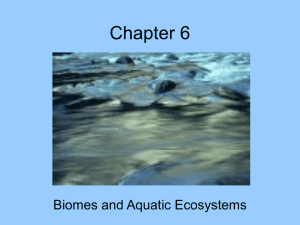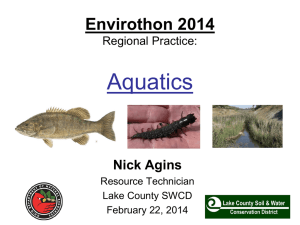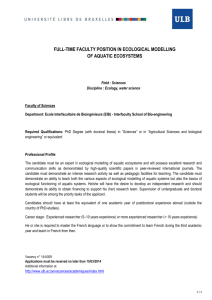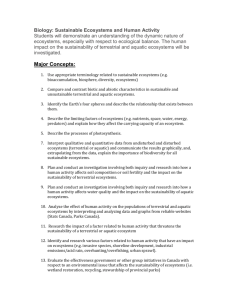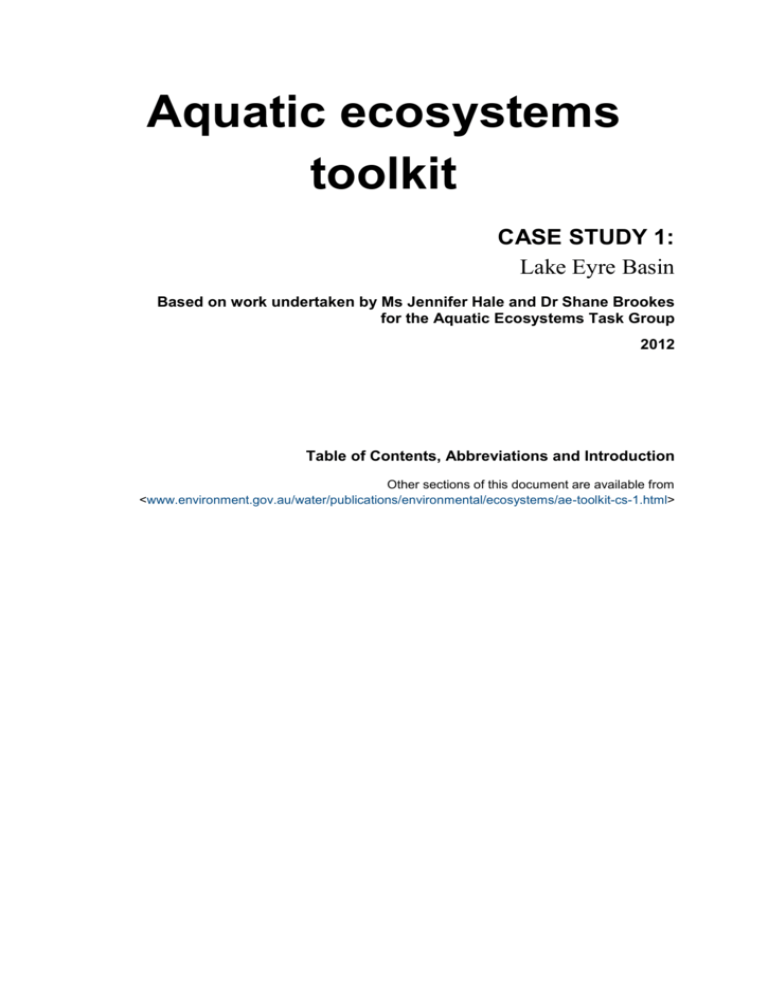
Aquatic ecosystems
toolkit
CASE STUDY 1:
Lake Eyre Basin
Based on work undertaken by Ms Jennifer Hale and Dr Shane Brookes
for the Aquatic Ecosystems Task Group
2012
Table of Contents, Abbreviations and Introduction
Other sections of this document are available from
<www.environment.gov.au/water/publications/environmental/ecosystems/ae-toolkit-cs-1.html>
Published by
Department of Sustainability, Environment, Water, Population and Communities
Authors/endorsement
This case study is based on trials of the draft Guidelines for Identifying High Ecological Value Aquatic
Ecosystems, and the draft Aquatic Ecosystem Delineation and Description Guidelines. The final reports from
these trials are as follows:
Hale, J. (ed.) (2010). Lake Eyre Basin High Conservation Aquatic Ecosystem Pilot Project. Report
prepared for the Aquatic Ecosystems Task Group and the Department of Environment, Water,
Heritage and the Arts. Jennifer Hale, Kinglake.
Hale, J., and Brooks, S. (2011). Trialling the guidelines for the delineation of High Ecological Value Aquatic
Ecosystems (HEVAE) in the Lake Eyre Basin (LEB). Report prepared for the Aquatic Ecosystems Task Group
and the Department of Sustainability, Environment, Water, Population and Communities. Jennifer Hale, Kinglake.
These reports are available on request from the Australian Government Department of Sustainability,
Environment, Water, Population and Communities.
Endorsed by the Standing Council on Environment and Water, 2012.
© Copyright Commonwealth of Australia 2012
This work is copyright. You may download, display, print and reproduce this material in unaltered form only
(retaining this notice) for your personal, non-commercial use or use within your organisation. Apart from any use
as permitted under the Copyright Act 1968 (Cwlth), all other rights are reserved. Requests and enquiries
concerning reproduction and rights should be addressed to Department of Sustainability, Environment, Water,
Population and Communities, Public Affairs, GPO Box 787 Canberra ACT 2601 or email
<public.affairs@environment.gov.au>.
Disclaimer
The views and opinions expressed in this publication are those of the authors and do not necessarily reflect those
of the Australian Government or the Minister for Sustainability, Environment, Water, Population and Communities,
nor the participating jurisdictional governments or ministers (Queensland, NSW, South Australia and Northern
Territory).
While reasonable efforts have been made to ensure that the contents of this publication are factually correct, the
Commonwealth does not accept responsibility for the accuracy or completeness of the contents, and shall not be
liable for any loss or damage that may be occasioned directly or indirectly through the use of, or reliance on, the
contents of this publication.
These trials were undertaken during the time when guidance on the identification, delineation and description of
aquatic ecosystems was an area of active policy development. The work informing the contents of this publication
was carried out under budgetary and time restraints, resulting in limited ability to incorporate all available
datasets and information into the process.
Citation
Aquatic Ecosystems Task Group (2012). Aquatic Ecosystems Toolkit. Case Study 1: Lake Eyre Basin.
Department of Sustainability, Environment, Water Population and Communities, Canberra.
For citation purposes, the PDF version of this document is considered the official version. The PDF is available
from:
<www.environment.gov.au/water/publications/environmental/ecosystems/ae-toolkit-cs-1.html>
ii
Table of contents
List of figures ...........................................................................................................................................iii
List of tables ........................................................................................................................................... vi
Abbreviations .........................................................................................................................................vii
Introduction.............................................................................................................................................. 1
Part 1: Identifying High Ecological Value Aquatic Ecosystems (HEVAE) ............................................... 2
1.1
Groundwork before identifying HEVAE .............................................................................. 2
1.2
Identifying HEVAE .............................................................................................................. 9
Part 2: Aquatic ecosystem delineation and description ........................................................................ 56
2.1
Assessment Unit 6455—Dalhousie Springs ..................................................................... 56
2.2
Assessment Units 4264, 4293, 4438—Lake Galilee ........................................................ 66
2.3
Assessment Units 1000, 1001, 1002—Coongie Lakes .................................................... 75
2.4
Assessment Units 4779, 5088, 5093, 5094—Chewings Range spring-fed pools ............ 86
References ............................................................................................................................................ 93
List of figures
Figure 1
Map of the Lake Eyre Basin drainage division showing major river systems and
jurisdictional boundaries ..................................................................................................... 3
Figure 2
Spatial scales used in the LEB HEVAE trial ....................................................................... 5
Figure 3a
Surface Water Management Areas (SWMA) in the Lake Eyre Basin ................................ 6
Figure 3b
Interim Bioregionalisation of Australia (IBRA) regions within the Lake Eyre Basin ........... 6
Figure 4
Assessment units in the LEB using the 500-square-kilometre nested
catchments data set ........................................................................................................... 8
Figure 5a
Attribute 1A—Diversity of aquatic ecosystems ................................................................. 22
Figure 5b
Attribute 1B—Number of fish species............................................................................... 23
Figure 5c
Attribute 1B—Number of waterbird species ..................................................................... 24
Figure 5d
Attribute 1B—Number of reptile species .......................................................................... 25
Figure 5e
Attribute 1B—Number of frog species .............................................................................. 26
Figure 5f
Attribute 1B—Presence of mammal (water rat) ................................................................ 27
Figure 5g
Attribute 1B—Number of woody plant species ................................................................. 28
Figure 5h
Attribute 1B—Number of non-woody plant species .......................................................... 29
Figure 6a
Diversity attributes combined and weighted ..................................................................... 30
Figure 6b
Diversity attributes combined not weighted ..................................................................... 30
iii
Figure 7a
Attribute 2A—Threatened species.................................................................................... 32
Figure 7b
Attribute 2B—Priority species ........................................................................................... 32
Figure 7c
Attribute 2C—Migratory waterbirds .................................................................................. 33
Figure 7d
Attribute 2E—Presence of the threatened ecological community of the GAB springs..... 33
Figure 8
Distinctiveness attributes combined and weighted........................................................... 34
Figure 9a
Attribute 3A—Waterbird abundance ................................................................................ 35
Figure 9b
Attributes 3B—Waterbird breeding ................................................................................... 35
Figure 9c
Attribute 3C—Refugia ...................................................................................................... 36
Figure 10
Vital habitat attributes combined and weighted ................................................................ 36
Figure 11
Evolutionary history—endemic species ........................................................................... 37
Figure 12a Mean Flow Disturbance Index .......................................................................................... 38
Figure 12b Mean Catchment Disturbance Index ............................................................................... 39
Figure 13
Assessment units that scored ‘very high’ in at least one criterion (criteria 1 to 4)
or contained representative wetland types ....................................................................... 41
Figure 14
Nominated distinctive, rare or threatened geomorphic, hydrological or
ecological features (including those important for evolutionary history) from
the Northern Territory, together with high-ranking assessment units ............................... 48
Figure 15
Nominated distinctive, rare or threatened geomorphic, hydrological or
ecological features (including those important for evolutionary history) from
Queensland, together with high ranking assessment units .............................................. 51
Figure 16
Nominated distinctive, rare or threatened geomorphic, hydrological
or ecological features (including those important for evolutionary history)
from South Australia, together with high-ranking assessment units ............................... 54
Figure 17
Aquatic ecosystems that contribute significantly to the values of
assessment unit 6455 ...................................................................................................... 58
Figure 18
IBRA subregions surrounding the core elements identified within
assessment unit 6455 ....................................................................................................... 59
Figure 19
Land use surrounding the core
elements identified within assessment unit 6455 (2008 Land Use) ................................. 59
Figure 20
Land systems mapping of the area surrounding the core elements identified
within assessment unit 6455 (South Australian Land System mapping) ......................... 60
Figure 21
Dominant vegetation classes in the area surrounding the core elements identified
within assessment unit 6455 (South Australian vegetation ID mapping). ........................ 61
Figure 22
Location of species records for wetland-dependent flora and fauna in
assessment unit 6455 ....................................................................................................... 62
Figure 23
Boundary of wetted soil profile surrounding the core elements identified
within assessment unit 6455 as determined by 3 m airborne imagery 2010 ................... 63
Figure 24
Delineated HEVAE ecological focal zone containing the Dalhousie Springs complex .... 63
iv
Figure 25
Aquatic ecosystems that contribute significantly to the values of assessment units
4264, 4293, and 4438 ....................................................................................................... 68
Figure 26
IBRA subregions surrounding the core elements identified within assessment
units 4264, 4293, and 4438 .............................................................................................. 69
Figure 27
QLD Regional Ecosystem mapping surrounding the core elements identified
within assessment units 4264, 4293, and 4438 (Wetland mapping and
classification for Queensland 2009) ................................................................................. 69
Figure 28
Location of species records for wetland-dependent flora and fauna in
assessment units 4264, 4293, and 4438 .......................................................................... 70
Figure 29
Core element (Lake Galilee) and suggested ecological focal zones for geology,
macroinvertebrates and waterbirds. The delineated HEVAE ecological focal
zone encompasses all component EFZ and is therefore the same as
the waterbird EFZ ............................................................................................................. 72
Figure 30
Aquatic ecosystems that contribute significantly to the values of assessment
units 1000, 1001 and 1002. ............................................................................................. 77
Figure 31
IBRA subregions surrounding the core elements identified within assessment
units 1000, 1001 and 1002 ............................................................................................... 78
Figure 32
Dominant vegetation classes in the area surrounding the core elements identified
within assessment units 1000, 1001 and 1002 (South Australian vegetation
ID mapping) ...................................................................................................................... 79
Figure 33
2008 land use surrounding the core elements identified within assessment
units 1000, 1001 and 1002 ............................................................................................... 79
Figure 34
Land systems mapping of the area surrounding the core elements identified
within assessment units 1000, 1001 and 1002 ................................................................ 80
Figure 35
Location of species records for wetland-dependent flora and fauna in assessment
units 1000, 1001 and 1002. Stars indicate locations with species listed as rare,
vulnerable or endangered in South Australia ................................................................... 81
Figure 36
One in 10 year flood inundation limit for the lower Cooper Creek containing the
core elements identified within assessment units 1000, 1001 and 1002 ......................... 82
Figure 37
Delineated HEVAE ecological focal zone containing Coongie Lakes and wetlands
of the lower Cooper Creek ............................................................................................... 83
Figure 38
Aquatic ecosystems that contribute significantly to the values of assessment units
4779, 5088, 5093 and 5094 .............................................................................................. 88
Figure 39
IBRA subregions surrounding the core elements (Chewings Range spring-fed pools)
identified within assessment units 4779, 5088, 5093 and 5094 ....................................... 89
Figure 40
Distribution of the Chewings Range quartzite formation (Digital Geology of the
Northern Territory) ............................................................................................................ 89
Figure 41
Delineated HEVAE ecological focal zone containing Chewings Range spring-fed pools
.......................................................................................................................................... 90
v
List of tables
Table 1
Key attributes used to classify non-riverine and riverine aquatic ecosystems
across the Lake Eyre Basin ................................................................................................ 4
Table 2
Attributes and metrics used to identify potential HEVAE in the Lake Eyre Basin,
and their rationale and data requirements ........................................................................ 10
Table 3
Agreed weightings for attributes ....................................................................................... 20
Table 4
Summary of assessment units that scored very high in at least one criterion
(C1 to C4). ‘Very high’ scores shaded .............................................................................. 42
Table 5
Nominations for distinctive, rare or threatened geomorphic, hydrological or
ecological features (including those important for evolutionary history) from the NT,
together with the outcomes of the scoring ........................................................................ 49
Table 6
Nominations for distinctive, rare or threatened geomorphic, hydrological or
ecological features (including those important for evolutionary history) from
Queensland, together with the outcomes of the scoring .................................................. 52
Table 7
Nominations for distinctive, rare or threatened geomorphic, hydrological or
ecological features (including those important for evolutionary history) from the
South Australia, together with the outcomes of the scoring ............................................. 55
Table 8
Outputs of LEB HEVAE trial for assessment unit 6455 .................................................... 57
Table 9
Outputs of LEB HEVAE trial for assessment units 4264, 4293, 4438
(highest rank shown) ........................................................................................................ 66
Table 10
Outputs of LEB HEVAE trial for assessment units 1000, 1001, 1002
(highest rank shown) ........................................................................................................ 75
Table 11
Outputs of LEB HEVAE trial for assessment units 4779, 5088, 5093
(highest rank shown) ........................................................................................................ 86
vi
Abbreviations
AETG
Aquatic Ecosystems Task Group
ANAE
Australian National Aquatic Ecosystems (Classification Scheme)
AquaBAMM
Aquatic Biodiversity Assessment Mapping Methodology
AWRC
Australian Water Resources Council
CAMBA
China–Australia Migratory Bird Agreement
CDI
Catchment Disturbance Index
CFEV
Conservation of Freshwater Ecosystem Values Framework
DEM
Digital Elevation Model
DSEWPaC
Department of Sustainability, Environment, Water, Population and Communities
EFZ
Ecological Focal Zone
EPBC
Environment Protection and Biodiversity Conservation Act 1999 (Cwlth)
ERP
Expert Reference Panel
GAB
Great Artesian Basin
Geofabric
Australian Hydrological Geospatial Fabric
HCVAE
High Conservation Value Aquatic Ecosystems
HEVAE
High Ecological Value Aquatic Ecosystems
IBRA
Interim Biogeographic Regionalisation of Australia
IUCN
International Union of Conservation of Nature
JAMBA
Japan–Australia Migratory Bird Agreement
LEB
Lake Eyre Basin
NCB
National Catchment Boundaries
NRETAS
Department of Natural Resources, Environment, The Arts and Sport (Northern
Territory)
RDI
River Disturbance Index
ROKAMBA
Republic of Korea–Australia Migratory Bird Agreement
SWMA
(Australian) Surface Water Management Areas
TWG
Technical Working Group
vii
Introduction
Draft components of the national Aquatic Ecosystems Toolkit, developed by the Aquatic Ecosystems
Task Group (AETG), were trialled in the Lake Eyre Basin. Trial application of module 3 was
undertaken by a multijurisdictional team, led by Jennifer Hale, and module 4 by Jennifer Hale and
Shane Brooks.
The base information developed and collated was done so within time and resource constraints and
with regard to the objectives of the High Ecological Value Aquatic Ecosystems (HEVAE) trial and the
HEVAE ‘Framework’ as it was at that time. Therefore, while the ancillary outcomes of this project such
as the aquatic ecosystem mapping may be fit for the purpose of this trial, they should not be
considered final products.
Note that at the time the trial was undertaken:
The terminology ‘High Conservation Value Aquatic Ecosystems’ (HCVAE) was still in use.
However, to reflect the change in name to ‘High Ecological Value Aquatic Ecosystems’, the
term HEVAE has been used in this case study, consistent with the other toolkit documents.
Module 3: Guidelines for Identifying High Ecological Value Aquatic Ecosystems (HEVAE) was
known as the HEVAE Framework.
There were six HEVAE criteria; ‘evolutionary history’ has since been incorporated into
‘distinctiveness’.
1



